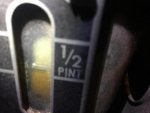Here we go again....
So she handled her 200-mile journey yesterday beautifully. No issues whatsoever except I noticed it’s running a little rich.
When I got home though, I noticed a little puddle of 363 on the right side of the car, and fluid was depleted even though I just topped it off before the trip. I guess I’m doing the brake job on this car sooner than I thought.
So I put the car up on ramps hoping maybe it was just a hose or something. I could see the line that was wet, but I couldn’t figure out why the support spring and areas above that line were wet. The accumulator and valve seem to be dry.
Drying it off, starting the car, and waiting for it to drip didn’t do anything, so I had my wife get in and pump the brakes while I watched. Best I can see, it look like it’s squirting out the back side of the valve, directed up and to the rear, then dripping down from there. Why would pumping the brakes affect this? Shouldn’t it be most pressurized when the brakes aren’t being applied?
I have a sphere on the way out anyway, and the other one is severely depleted on nitrogen.
How hard is this going to be? I am extremely intimidated by this hydraulic system, but I’m getting more familiar with it. Is it possible it’s not the valve? Are there other lines up there I can’t see?
So she handled her 200-mile journey yesterday beautifully. No issues whatsoever except I noticed it’s running a little rich.
When I got home though, I noticed a little puddle of 363 on the right side of the car, and fluid was depleted even though I just topped it off before the trip. I guess I’m doing the brake job on this car sooner than I thought.
So I put the car up on ramps hoping maybe it was just a hose or something. I could see the line that was wet, but I couldn’t figure out why the support spring and areas above that line were wet. The accumulator and valve seem to be dry.
Drying it off, starting the car, and waiting for it to drip didn’t do anything, so I had my wife get in and pump the brakes while I watched. Best I can see, it look like it’s squirting out the back side of the valve, directed up and to the rear, then dripping down from there. Why would pumping the brakes affect this? Shouldn’t it be most pressurized when the brakes aren’t being applied?
I have a sphere on the way out anyway, and the other one is severely depleted on nitrogen.
How hard is this going to be? I am extremely intimidated by this hydraulic system, but I’m getting more familiar with it. Is it possible it’s not the valve? Are there other lines up there I can’t see?












